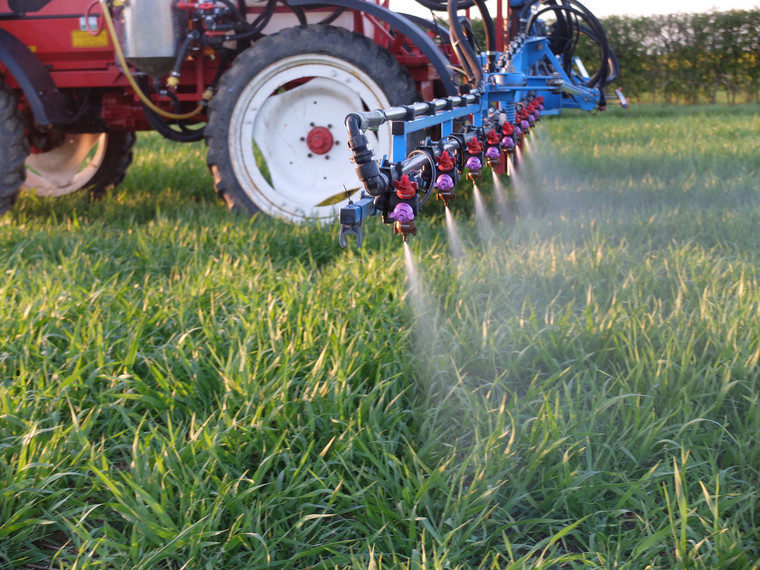Using 75% drift reduction nozzles, rather than conventional flat fan nozzles, for flag leaf fungicide spraying can boost winter wheat yield by 0.75 t/ha, according to new Syngenta research.
But if spraying conditions require ’increasing’ to 90% drift reduction nozzles, then higher water volumes will be needed to compensate, results suggest.
Conducted last season in response to growers having to focus increasingly on ways of reducing spray drift, the work showed that yield from a flag leaf (T2) application of the SDHI fungicide Elatus Era was boosted from 8.25 to 9 t/ha when applied through 75% drift reduction Amistar nozzles, compared with conventional flat fan nozzles.
Yield with the Amistar nozzles, which are also known as Guardian Air nozzles, also remained at 9 t/ha irrespective of whether a typical water volume of 100 l/ha, or a higher water volume of 200 l/ha, was used.
However when 90% drift reduction nozzles were used at the traditional 100 l/ha water volume, yield fell by over 0.5 t/ha compared with the conventional fan nozzles. Only when water volume was doubled to 200 l/ha did yield climb back nearer to the 8.25 t/ha of the conventional nozzles.
“Growers increasingly need to incorporate better drift reduction into spraying operations,” explains Syngenta application expert, James Thomas, “so we were keen to investigate this.
“Key factors to consider in reducing drift include using the correct sprayer speed and boom height and fitting the correct nozzles. Halving the sprayer speed can reduce drift four-fold, while halving boom height from 1 metre to 50cm can reduce drift as much as ten-fold. Also, many more growers are now using drift reduction nozzles, but it is important to choose the correct ones for the job.”
Mr Thomas says the coarse droplets produced by nozzles that reduce drift the most are good at getting the spray down into the cereal canopy, rather than being blown about. However, coarser droplets tend to produce reduced coverage of the spray target than finer droplets, he says, so higher water volumes are needed to compensate.
“Based on these new results, our latest guidance is to use 75% drift reduction nozzles, such as Amistar nozzles, at T1 and T2 at either 100 or 200 l/ha of water in normal conditions. However, in conditions when drift reduction is even more important, our guidance is to switch to 90% drift reduction nozzles, but to use a minimum of 200 l/ha of water.
“Although spraying in 200 l/ha rather than 100 l/ha of water can mean 30% fewer hectares are sprayed per day, due to more frequent fill-ups, using 90% drift reduction nozzles could mean the difference between being able to spray on a given day or not. At T2, for every day that disease control is delayed, it is worth remembering that wheat yield can decline by 70 kg/ha.”
This guidance for a higher water volume with 90% drift reduction nozzles was underlined in further testing at T1. In this work, applying a mixture of an azole and the multi-site fungicide folpet in anything less than 200 l/ha of water resulted in poorer yellow rust control than conventional fan nozzles at 100 l/ha of water, Mr Thomas notes.
When applying earlier-season T0 fungicides, he suggests growers should consider angled nozzles alternating backward and forward-facing along the spray boom, such as Defy 3D nozzles. Use of alternating backward and forward-facing Defy nozzles should also be considered for ear sprays at T3, he suggests.




